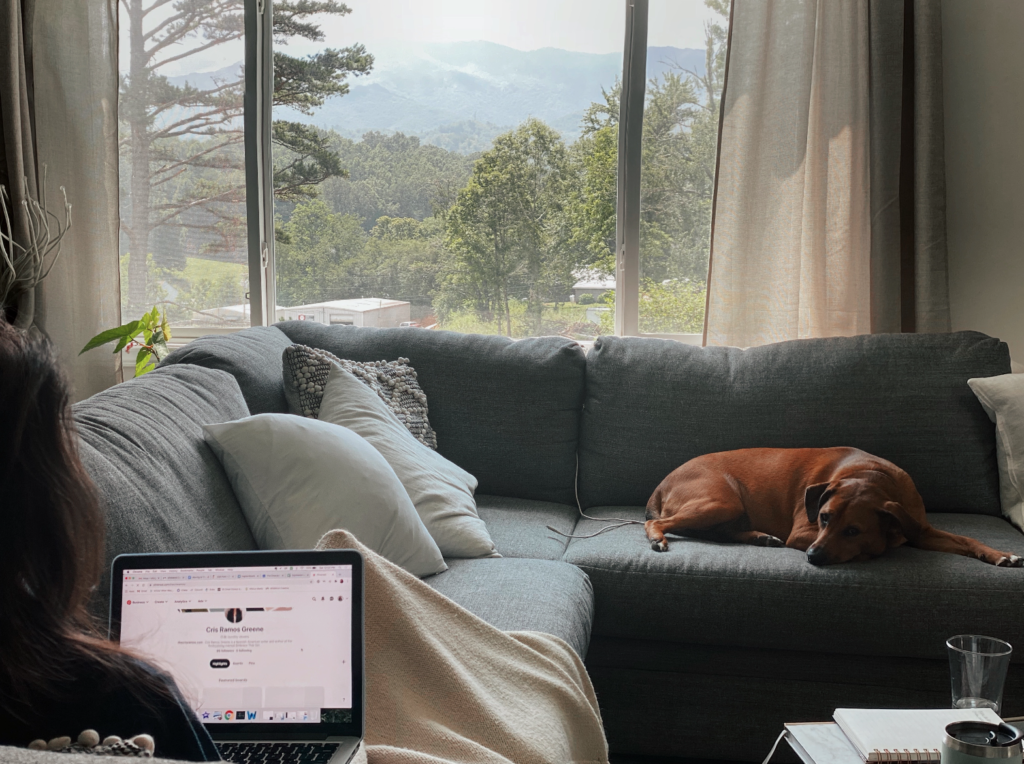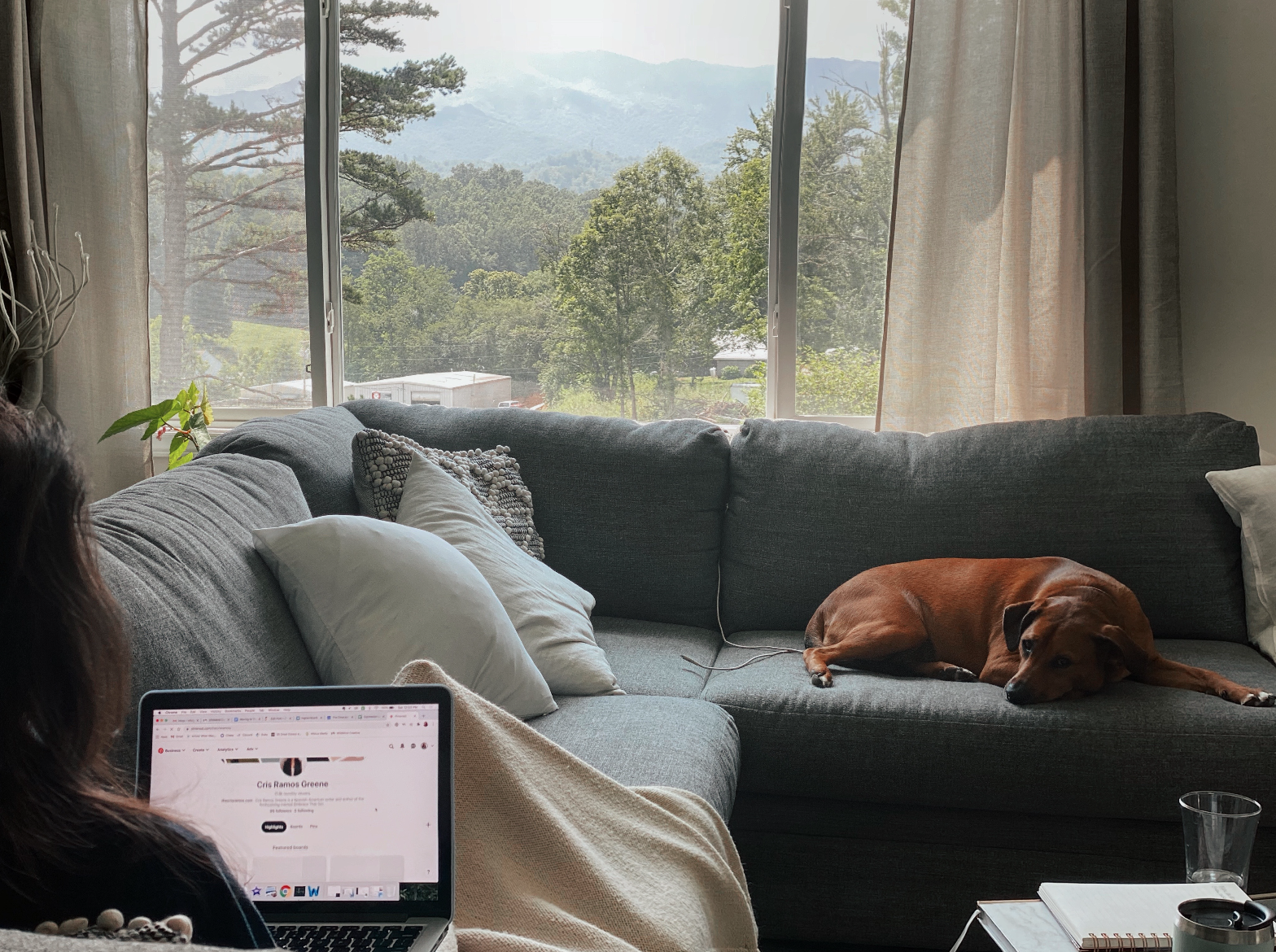Fresh coffee in hand, I settle into my “grandpa chair.” This is my writing spot as of late. It’s an old thrift find that’s olive green (or the color of cat poop, as my husband says) with a missing spring. My vintage throne sits in the corner of our small office. The chair and desk have since been claimed by my husband, who works from home, but this old eyesore of a chair is all mine. This is where I get comfy and write.
My writing routine has taken a decade of trial and error to develop. I didn’t realize I had a system until I put this post together. I’ve gotten some of the ideas from asking artists, listening to podcasts, and my own natural inclinations.
Warning: There is no right way to write. I wish I could tell you the below is sustainable, but it’s not. Not even for me, a writer by vocation. I used to feel bad about going through intense periods of consistent writing followed by periods of no writing at all, until one day Cheryl Strayed explained her own process as a series of sprints and pauses. She doesn’t buy into the “you have to write every day” advice, which is everywhere if you search for writing routines. I agree.
Here’s my writing routine in 7 steps. Try it on, if it resonates. May it serve you on your journey 🙏🏼

Step 1: Journal / Morning Pages
Ah, the brain dump. I let go of a lot of garbage daily in my journal. It’s a surprising amount and yet it refills itself every night… it’s consistent like that. There’s never a shortage of worries, tasks, insecurities, curiosities, annoyances, to do lists… all the filler stuff that gets in the way of living. You may know it as Morning Pages from The Artist’s Way, you may do Bullet Journaling, or any other method, whatever it looks like: journal in the morning.
Why? Well, first it gets all the crap floating around your brain out. Second, once in a while, something insightful and magic will happen. Third, it’s practical and you will begin to spot patterns and answers to issues and questions in your life.
I find it does all the above depending on where I’m at in my life. Journaling can be hard to get into and yet it is so beneficial. It’s truly the flossing of the personal development world. You’re either into it or you’re not, but you know it’s good for you.
Pro tip: I give myself a 10 minute timer and prompts (questions I have for myself) and it helps speed things along. It’s my equivalent of: “Gun to your head, would you…” You have all the answers inside you. You only need to ask the right questions and provide space for the answers.
Step 2: Be Inspired / Participate
I read something short before I write. I love essays for this. Some days it’s Modern Love in the New York Times, other days it’s David Sedaris, or a chapter of my current read (if it’s a book, I don’t allow over a chapter). The point of this exercise is twofold: the first (and most important), it inspires me. When I read someone’s story, it helps me want to tell my own. Second, it keeps me current on what’s out there and a participant in the lit world. If I want people to read my work, for the sake of that (and good karma) I read other writers’ works. This is not my leisure reading time though, I keep this read short because it leads to the next and most important step…
Step 3: Write, write, write (Just Do it)
The most important step in a writing routine is… writing. Nailed it!
I’ll elaborate. I’m not a disciplined person who gets right into it, unless it is a glass of wine and Gossip Girl. For everything else, writing included, it takes some getting warmed up. I need to have coffee and stretch my legs before I go on a run. That’s what journaling and reading do for me, they get me in an inspired place to do the damn thing. And sometimes, I still don’t want to. Like a petulant child who throws tantrums, my writing requires skillful enrollment. Some days it miraculously flows and others it needs to be coaxed. It’s usually the second, unfortunately. But once I get into it, even if I didn’t want to, it begins to flow somewhere in the middle. Like right now in this article I tried to talk myself out of writing.
Step 4: Edit, edit, edit (Add Polish)
The second most important step in writing is editing. I cannot overstate this. The first draft is never final. That’s crazy. Most of writing is editing it feels like. I read my book 5 times (yes, all the way through) in the past 6 months for the sake of editing. And I still found stuff. I like to let it sit for a day or longer, and then read it with fresh eyes. I also recommend reading books on how to edit, like William Zinsser’s On Writing Well.
There’s not much more to say here. Edit your own work and get good at that. Even if you work with an editor, I can’t tell you how much of a stronger writer you’ll be when you realize how to cut out “the fat,” string a good story along, etc.
Step 5: Write Ideas Down Throughout The Day
I am like the cat lady of notebooks. Seriously, I own about 15 notebooks (unused) and I have anywhere from one to three I write in at a time. But I capture ideas when they come to me which is vital! Ideas are finicky and have their own independent energy. Elizabeth Gilbert has a cool theory and story on ideas in Big Magic. They’re unpredictable and hop around trying to find their best host. So, timing is of the essence, when an idea hits you… stop whatever you’re doing and write it down. Because, guess what, they typically do not come to you at your allotted writing time. They are like the random fuckboy you liked in college that wouldn’t commit: you just never knew when he’d call or resurface. Could be every day or could be weeks.
Write ideas down so you can refer to them when you sit down and get ready to do the damn thing, otherwise known as step 3.
Step 6: Share
Share your work! Austin Kloen has a terrific book about this for artists who tend to be shy about that. If you are reading this it means you have a story to write and share. Sharing is part of the artistic process, it’s how we express ourselves and connect with people. When we allow ourselves to be seen, we provide a space for someone else to grow and do the same. It’s also the scariest part of the process. My heart as a fellow artist is with you because nothing is guaranteed, people can be cruel, and sometimes you may get crickets (which can be worse than negative feedback). I get it. My best advice here, and I will recall the wise sage of my Queen Elizabeth Gilbert: don’t take it personally.
Although writing a book (or creating any other type of art) can feel like you birthed something… you really didn’t. You made something cool (maybe something beautiful, weird, inspiring, thought-provoking, etc.)… that’s what happened. The most important part was for you. (Remember? Step 3 – most important part – only you are involved). The value was in the creation, in the journey.
It may resonate, it may not. If it’s doesn’t, it may mean something (valuable feedback you can apply) or it may not mean anything (you may not have shared it with the right people or in the right way). Sharing is important for you and once you do this, you get to surrender and let it be whatever it needs to be for people. Lastly, give it the best chance by believing in yourself (even if it’s really good, I promise if you don’t believe in it no one else will).
Step 7: Don’t Give Up
Stay. In. The. Game. Whether you’re working on a project, coming off a success, or even a failure, please do not leave this wonderfully weird world of creativity. We need you. We need your words, your art, your point of view. It can be hard, it can be thankless, and it can be a miracle if you let it be. Your success is in your staying power, always. Don’t give up, don’t ever ever give up.
xoxo.
c
